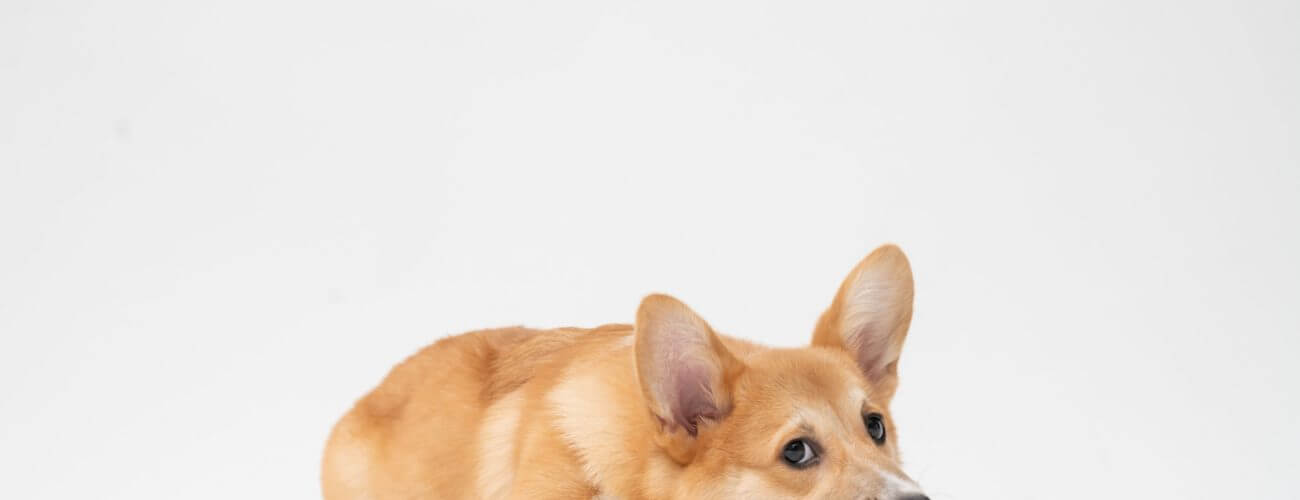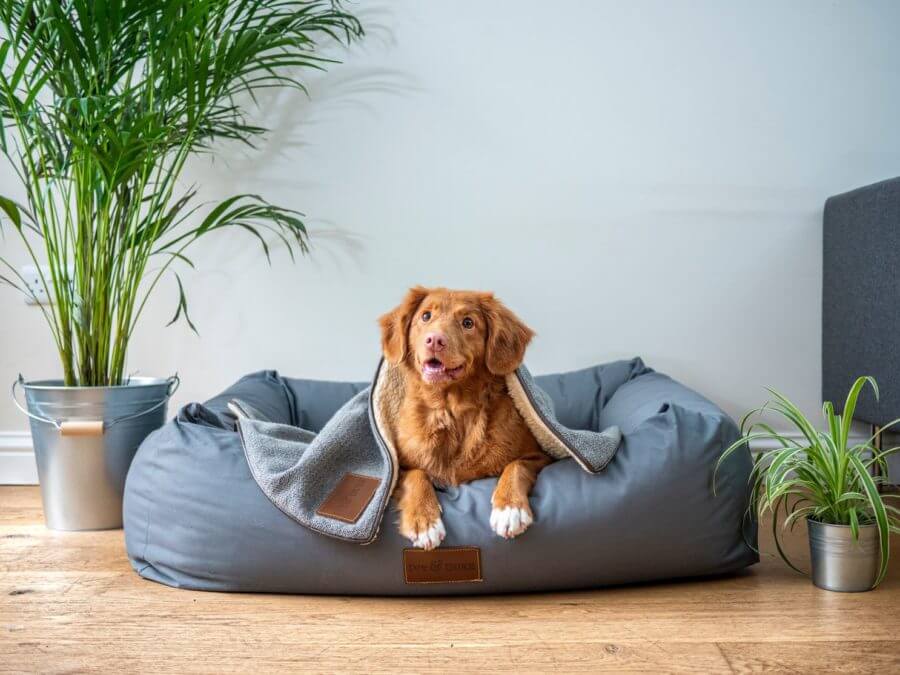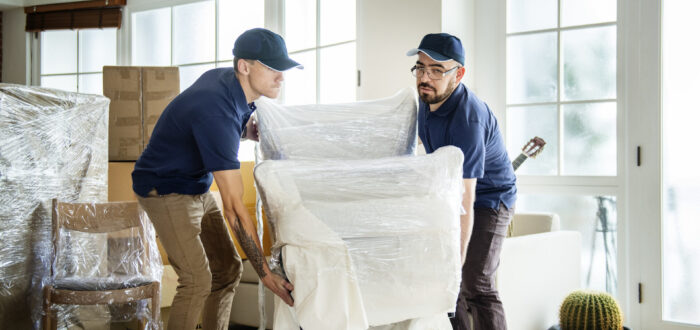

How to Make Moving With a Dog Stress-Free for Both of You
Posted in How-to,Moving Essentials,Moving Tips & Tricks on December 7, 2021
If you have a beloved canine and have to move in the near future, the chances are that you’re worried about the effects of relocation on your pet. Is moving with a dog something you should worry about? How does a move affect a dog? If these are the dilemmas that trouble you, you’ve come to the right place – we will explain everything you need to know on how to get your pup through this challenging period.
What Do Our Furry Friends Experience During a Move? Is Moving Stressful for Dogs?
Once you start planning your efficient move, the chances are you’ll feel pretty stressed out – anybody who’s ever moved can tell you that a stress-free move is basically an impossible thing. Organizing a relocation requires time and dedication, but you know that you have a compelling reason to move, so you keep going, checking off tasks from the to-do list one by one. However, your furry friend has no idea what is happening. What is going through your pup’s head while you pack dishes and furniture? Have you thought about how will relocating to a new state affect your pet? Do dogs do OK with moving?
Will Your Furry Friend Be Stressed Out Because of the Move?
Unfortunately, dogs feel anxiety about the move, just as humans do. However, while you’re stressing over possible relocation mistakes, your pet will simply be confused about everything that’s happening right now. Dogs get used to living in one home, and changing that can throw them off. They love having their territory and a certain routine you’ve established – when all that changes from the roots, they experience stress. Can you somehow make relocating with pets less stressful for the both of you?
Moving Dog to New Home Doesn’t Have to Be Scary If You Know How to Prepare Them for a Change
It’s going to take a while for you to pack up your whole household inventory, that’s for sure. That means your pup might get confused with all the chaos around the house and experience severe anxiety. When moving with dogs, it’s crucial to let them know that you’re not going anywhere without them – that should be your number one priority. There are a few relocation tips that can help you in this situation, and we’re going to share them with you below.

Don’t Overlook the Importance of a Good Old Routine – It Can Help the Both of You
When you’re planning a move to another city with your pup, it’s essential to keep in mind one thing – dogs need a routine. So, if you want to know how to move with a dog without traumatizing them, keeping up with your routine is undoubtedly the first step. Try to keep things as normal as possible, up until the moment your long-distance movers show up to provide their relocation services.
Your furry friend should get their food at the same time and play in the same park as usual. If you’re training the little one, keep it up as if nothing is going on. At first, this advice might seem pointless – this is easy, right? Well, it sure is when you’re not trying to pack countless fragile items in boxes or disassemble your furniture. But when there are relocation preparations, you’ll notice that it can be hard to get through the day with all the work you have to do, so sticking to routine might turn out to be a bit of a challenge. However, we advise you to do your best – it will mean a lot to your pup and make the transition less stressful.

Physical Exercise Can Be Quite Beneficial for Your Pet’s State of Mind in the Period Up to the Move
We can’t even say that this is a relocation hack – it’s more of a life hack if we’re honest. Virtually any vet would tell you that exercise is of utmost importance during such a stressful period in a canine’s life. This is quite logical – just like running can help a human get rid of the excess pressure, it can do the same for an animal. Your pup will feel more relaxed – plus, there are countless benefits for its physical health, as well.
Long Walks and Fetching Games Are a Crucial Part of Pre-Relocation Care
You should make it your priority to set aside enough time for daily walks. Try to prolong them a bit, and don’t forget to add time for playing with your four-legged friend. The game of fetch might become boring to you after a while, but stick to it until you see that the pup got bored as well – that means they spent all their energy and won’t have any more to channel into anxiety. This is basic psychology at its finest – it’s the same principle that works with kids.
Once you’re done playing with your pup, you can focus on packing – remember to research some packing tips that will fasten up the process. Still, there’s no reason to worry about this task – you can always book a packing service if you think you won’t be packed on time for the relocation day.

Dogs Are Sometimes Scared of Packing Supplies – You Will Have to Show Your Pet That They Have Nothing to Worry About
Boxes and packing paper aren’t anything terrifying for you, but they might frighten your pup in the beginning. Why would a canine be scared of supplies? They are unfamiliar, and when you add the sounds of ripping tape, it’s understandable that a pup can be confused. Luckily, getting pets used to boxes and other packing supplies isn’t challenging. We’ll share the trick with you.
Training the Pup Not to Fear the Supplies
A little training can go a long way in this case, and if you’re having a last-minute move, it’s good to know that this doesn’t take long, so you’ll be able to organize packing soon. How to get pets used to new items such as boxes? It’s not difficult – all you have to do is place a box or two in the corner where the furry one will notice them. Add a few other supplies as well. This setting should look accidental, so don’t try to draw attention to it. Let the canine find it on its own and explore it.
It won’t take long until they realize that it’s nothing scary. Additionally, you can use this hack to speed up the training process – when the pup approaches the box, give food to form a positive association with the supplies. When you see that the animal isn’t scared anymore, you can get to packing and deciding what to get rid of when you move.

Your Home Will Be a Mess During Packing, But Make Sure You Set Up an Area for Your Pup – They Really Need Safe Space Now
When your house gets turned upside down – which it will be once the relocation day starts to approach – the puppy will be confused with all the belongings lying around. That can trigger a stress reaction. You can fix this easily – just set up a place for the puppy to relax and rest. If possible, the safe space should be the one your canine is already used to. If you had to pack up that area, set the pup’s belongings somewhere else. What’s important is that they have a corner to keep at least some kind of routine before leaving for a new house.

It Would Be Best to Get a Trusted Dog Sitter for the Relocation Day
When long-distance movers come to load your belongings onto the relocation truck, it’s not wise to have pets running around. Of course, you will choose a reputable relocation company, but that’s not the issue. It’s not safe for pets (and kids as well, while we’re at it) to be around while movers do their magic, as they might get hurt. Plus, you will have a lot to do as well – the chances are that you won’t have time to care for a pup the way you would like to.
To avoid any possible issues, you can simply find a sitter for the relocation day. A trusted friend or a family member are the most obvious solutions. That way, you will have one less thing to worry about, and you can be fully present while long-distance movers pack the truck (additionally, you won’t forget to tip the movers for their exceptional service!).

The Move Is Finally Over – But How Will You Help Your Pet Adjust to a New Home?
The relocation is over, but your work isn’t done yet. You still have to unpack after the move and get your pup used to the new space. We know you’ll love your home, but the puppy probably won’t be so happy about it at first – canines can take a while to adjust. Now, the question is – can you do something to speed up the adjustment process?
How Long Does It Take for a Dog to Adjust to a Move and Can You Help Them Get There Faster?
Not all canines go through the same adjustment process – some might be fine right away, yet some might take days or even weeks to feel comfortable in their new environment. Of course, some tricks have been proven helpful in these situations. Considering that separation anxiety is a common issue in canines after the relocation, one of the things to do after the move might include taking care of this issue. The video below will share some valuable tips for this problem – check it out.
Pets Should Have a Safe Space in Their New Home – Be Sure to Set It Up
We’d like to share one more tip with you – just like you had the safe space for your furry friend in the old house, you should have it in the new one as well. If you can set it up to look like the previous safe area, that’s even better – that way, your pup will feel more comfortable in the unfamiliar environment. Additionally, you can bring the little one food there to enforce the positive association.

Long-Distance Moving With a Dog Can Be Challenging – Hire the Best Cross-Country Movers to Help You Get Through This Easily
We’ve talked about ways to take care of your four-legged friend during the relocation process, but we didn’t share how to keep your mental health in that period. Remember – that’s an important thing as well. How will your puppy feel fine if you’re not? Luckily, you don’t have to put the whole burden of the move on your back. If you hire professional long-distance movers, you will have way less on your plate – but keep in mind that the best movers will be booked weeks or even months in advance. Don’t put this task off – book the pros today.





